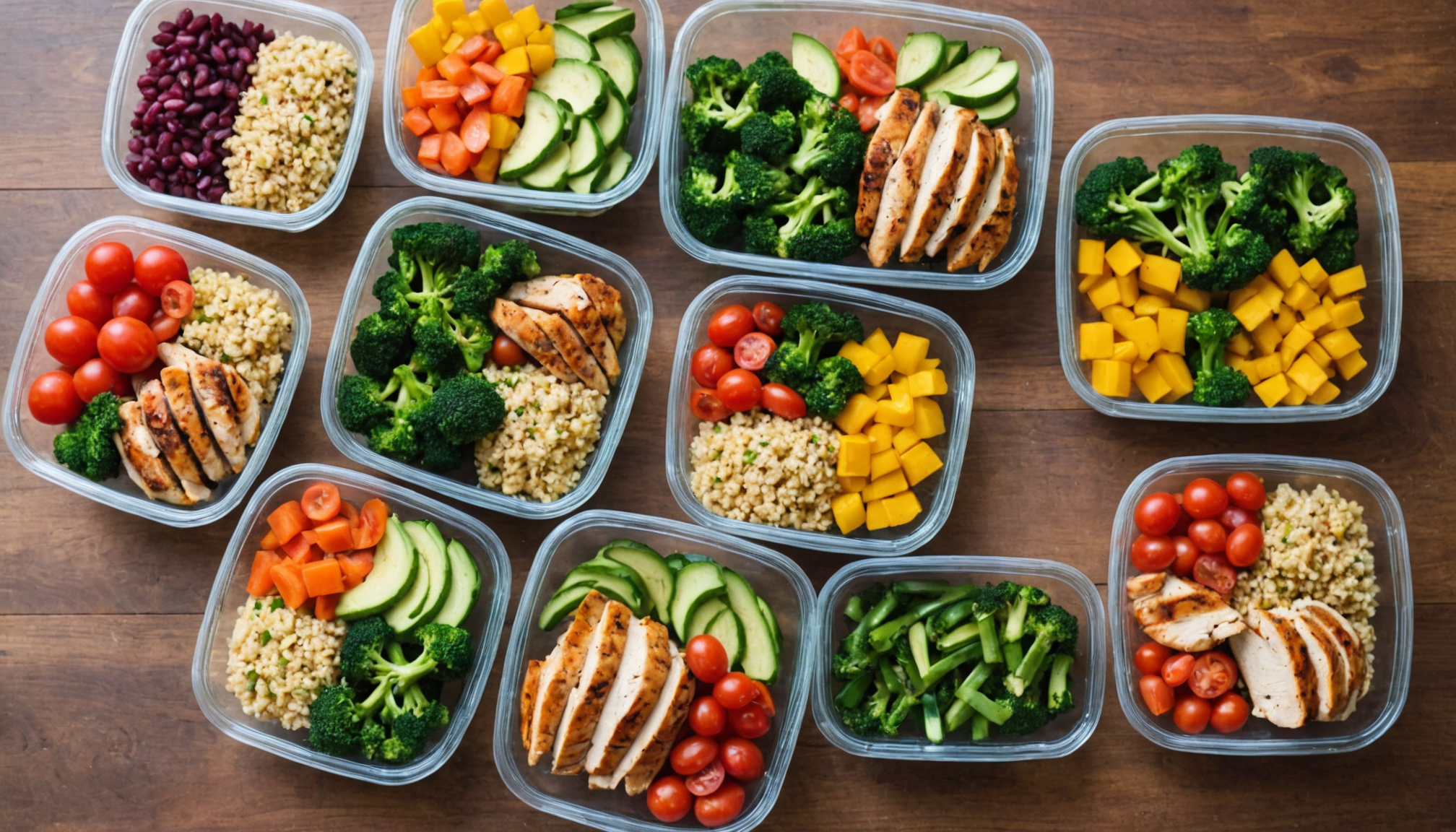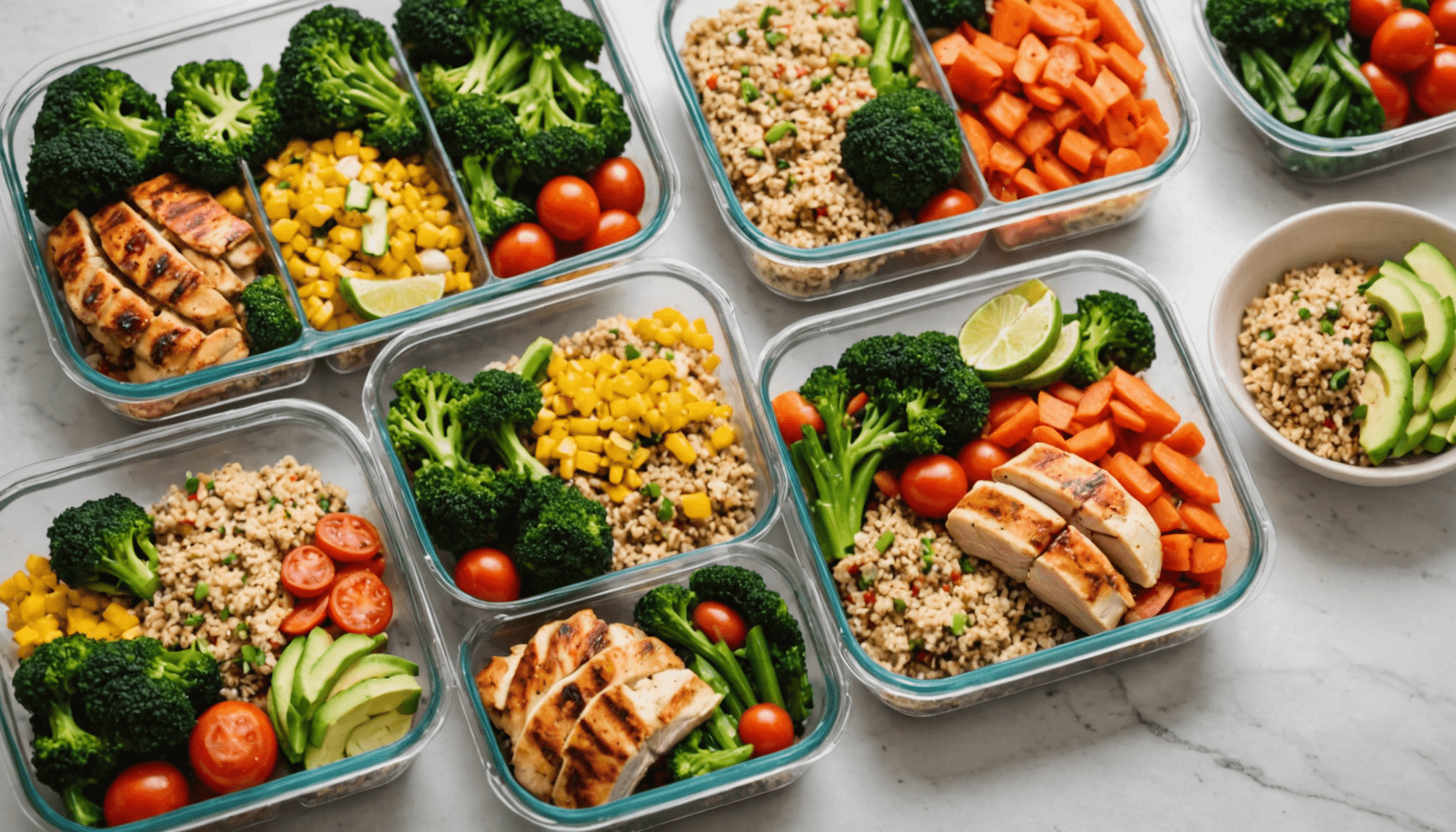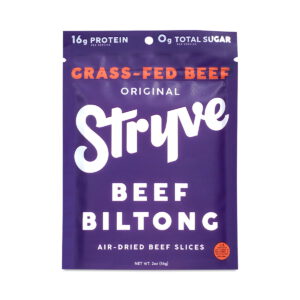- Healthy meal planning strategies
- Quick and nutritious snack ideas
- Batch cooking for busy weeknights
- Involving kids in meal preparation
- Healthy eating on a budget
- Tips for staying motivated and inspired
When it comes to grocery shopping, a well-thought-out approach can save busy parents both time and effort while ensuring that the family eats nutritious meals. Here are some practical tips and strategies that can enhance your shopping experience, whether you’re exploring local markets, searching online, or navigating the aisles of your favorite grocery store.
Prioritize Fresh and Local Ingredients: Buying seasonal produce not only supports local farmers but also guarantees fresher options with better flavor and nutritional value. Look for farmers’ markets in your area and consider signing up for a community-supported agriculture (CSA) program, where you can receive a weekly box of organic fruits and vegetables. Filling your cart with vibrant, seasonal produce can greatly enhance your family meals.
Make a Budget-Friendly List: Determine how much you can spend before you head out shopping. Create a list that balances healthy foods with affordability. Include staple items such as:
- Whole grains (brown rice, quinoa, whole-grain pasta)
- Beans and lentils (excellent vegan protein sources)
- Frozen fruits and vegetables (nutritious and long-lasting)
- Healthy fats (olive oil, nuts, seeds)
- Dairy alternatives (almond milk, coconut yogurt)
Buying in bulk can also be a great way to save money on items you use frequently. Just be sure to store them correctly to prevent spoilage.
Embrace Online Shopping Safety: Online grocery shopping can save time and effort, especially for busy parents. When shopping online, choose reputable retailers and always check for organic certifications when it comes to fresh produce and packaged items. Look for customer reviews to ensure quality. Also, consider the following points:
- Check for delivery options that maintain product freshness, such as insulated packing.
- Be cautious with substitutes; sometimes, the online system may replace an item with a less healthy version.
- Keep your payment information secure and avoid public Wi-Fi when entering sensitive information.
Incorporate Vegan Options: If your family enjoys plant-based meals, look for easy-to-integrate vegan products during your shopping trips. Items like vegan cheese, tofu, tempeh, and meat alternatives can make delicious family meals without compromising nutrition. Having a few ready-to-use vegan meals or ingredients in your pantry can be a lifesaver on particularly hectic days.
Safety First: When selecting packaged foods, pay attention to expiration dates and avoid products with overly long ingredient lists. Choose items that are as close to their natural state as possible, and steer clear of overly processed options laden with sugar or preservatives. This is crucial for maintaining a healthy eating pattern for busy parents and their families.
With these tips in mind, your grocery shopping experience can become not only more efficient but also more aligned with your health goals. Preparing your family to make informed choices at the grocery store will contribute significantly to creating lasting habits of healthy eating.
Quick and nutritious snack ideas
Quick and easy snacks are essential for busy parents looking to maintain their health and ensure their children receive nutritious options throughout the day. Having a selection of readily available snacks can curb hunger pangs, avoid unhealthy choices, and support a well-balanced diet. Here are some fantastic ideas that provide nourishment without compromising on taste or convenience.
One of the simplest ways to whip up healthy snacks is to embrace the power of fruits and vegetables. Fresh produce is naturally nutritious and requires minimal preparation. For example, apple slices paired with almond butter or carrot sticks served with hummus make for great snack options that are not only satisfying but also rich in vitamins and fiber. Additionally, consider preparing a veggie tray with a variety of colorful vegetables, including bell peppers, cucumbers, and cherry tomatoes. This can be a fun, healthy snack your kids can grab on the go!
If you’re looking for something more substantial, consider creating homemade energy bites, which are packed with nutrients and only take a few minutes to prepare. Mixing oats, nut butter, honey, and add-ins like chocolate chips or dried fruit can yield delicious and filling snacks. Simply roll them into small balls and store them in the refrigerator for a convenient option when hunger strikes.
For a bit of crunch, air-popped popcorn can serve as a healthy alternative to traditional chips. With a sprinkle of nutritional yeast, it transforms into a cheesy treat without the added calories of butter or excessive salt. To amp up the flavor, you can experiment with spices like paprika, cayenne, or garlic powder.
Here’s a handy comparison of some popular quick snack options, showcasing their nutritional benefits:
| Snack | Calories (per serving) | Main Nutrients | Benefits |
|---|---|---|---|
| Apple Slices with Almond Butter | 180 | Fiber, Healthy Fats, Vitamin E | Supports heart health and keeps you full longer |
| Carrot Sticks with Hummus | 150 | Fiber, Protein, Vitamin A | Good for eye health and a great source of plant-based protein |
| Homemade Energy Bites (2 pieces) | 200 | Protein, Healthy Fats, Iron | Provides sustained energy for busy parents and kids |
| Air-Popped Popcorn (3 cups) | 90 | Fiber, Antioxidants | Low-calorie snack option that keeps you satisfied |
Additionally, incorporating yogurt into your snacking routine can be beneficial. Greek yogurt with a drizzle of honey and a handful of berries makes for a delicious treat that is high in protein and full of antioxidants. This can be an excellent post-workout snack for parents or a midday boost for children needing a pick-me-up.
Don’t forget about the power of convenience foods. Pre-packaged snacks can be a lifesaver, but it’s crucial to choose wisely. Look for brands that offer organic or minimally processed options with no added sugars. Single-serving packs of nuts, dried fruits, or health bars can provide quick nutrition without the hassle.
By planning a variety of quick and nutritious snacks, busy parents can ensure that their families are well-fed, energized, and ready to take on the challenges of the day. Prioritizing healthy snack options not only encourages better eating habits but also sets an excellent example for children, promoting lifelong healthy eating practices within the family.
Batch cooking for busy weeknights

Batch cooking can transform your weekly meals and make busy weeknights less stressful. It requires a bit of planning but offers significant rewards in the form of time saved and healthier family meals. By dedicating a few hours each week to prepare larger quantities of nutritious dishes, you can have quick and healthy options ready to go when life gets hectic.
Choose Versatile Base Ingredients: Start with ingredients that can be used across multiple meals. Whole grains like quinoa, brown rice, or whole-grain pasta provide a hearty foundation for various dishes. Batch cooking these staples can make it easy to mix and match with different proteins and vegetables throughout the week.
Opt for Nutrient-Dense Proteins: Include a variety of proteins in your batch cooking to cater to everyone’s tastes. Some great options are:
- Grilled Chicken or Tofu: Both can be seasoned in different ways to keep meals exciting.
- Beans or Lentils: These are excellent for plant-based options and can be incorporated into salads, soups, and stews.
- Fish: Baked salmon or tuna can be quickly reheated for nutritious dinners.
Save Time with One-Pot Meals: One-pot meals are a lifesaver for busy parents. They often combine grains, proteins, and vegetables in a single dish, minimizing both cooking and cleaning time. Consider recipes such as:
- Quinoa Stir-Fry: Toss in whatever veggies you have on hand, along with your choice of protein, and season it for a quick meal.
- Chili: A big pot of chili can feed the family for several days, and it freezes well for future meals.
- Sheet Pan Dinners: Roast a combination of vegetables and proteins on one pan for a full meal with minimal effort.
Efficient Freezing Techniques: Properly storing meals is vital to retaining quality and safety. Once your meals are cooked, allow them to cool fully before portioning them into airtight containers or freezer bags. Label them with the date and contents to easily keep track of what you have on hand. Consider the following when freezing:
- Portion Sizes: Freeze in family-sized portions for larger meals or individual servings for quick lunches.
- Timing: Consume frozen meals within 2-3 months for the best quality.
- Thawing Safely: Plan ahead and defrost meals in the fridge overnight to minimize any food safety risks.
Involve the Kids: Make batch cooking a family affair! Engage your kids in the process by letting them help with simple tasks like washing vegetables, stirring pots, or assembling meals. Not only does this teach them valuable cooking skills, but it also fosters a connection with the food they eat, encouraging them to try new flavors and enjoy healthier options.
Smart Shopping Tips: As you gather ingredients for your batch cooking sessions, keep your grocery shopping efficient. Make a list focused on whole, nutrient-dense foods and stick to it. Look for sales on seasonal produce, bulk grains, and proteins, which can help you save money while equipping your kitchen with the essentials for healthy meals. Always double-check for organic options whenever possible, particularly for items like produce that are often exposed to pesticides.
By embracing batch cooking, busy parents can streamline their mealtime routine and ensure that nutritious, homemade meals are always on hand, ready for the family. This approach not only saves time throughout the week but also promotes healthy eating habits that the whole family can enjoy.
Involving kids in meal preparation
Engaging children in meal preparation not only makes the cooking process more enjoyable but also establishes a sense of teamwork within the family, fostering lifelong healthy eating habits. When kids participate in the kitchen, they become more aware of what they eat, which can lead to better food choices in the future. Here are practical ways to involve your little chefs in the culinary experience.
Start by assigning age-appropriate tasks that allow your children to contribute meaningfully. Younger kids can help wash vegetables, tear lettuce for salads, or mix ingredients in a bowl. As they grow older, involve them in more complex tasks such as chopping vegetables with child-friendly knives or measuring ingredients. This will not only build their confidence in the kitchen but also encourage a sense of accomplishment.
Consider implementing a “family cooking night” once a week. Choose a simple recipe that everyone can participate in, allowing each family member to take on a specific role. This could be a pizza night where kids can add their favorite toppings or a taco bar where everyone builds their own meal. Such activities turn cooking into a fun, interactive experience rather than a chore, and kids may be more likely to try new foods when they have a hand in preparing them.
Utilizing themed cooking challenges can also spark interest and creativity in your children’s culinary efforts. For example, set up a challenge where each family member must include a specific color of fruit or vegetable in their dish. This not only makes the process exciting but also subtly teaches them about nutrition and the importance of incorporating a variety of colors into their diet.
A valuable way to deepen their understanding of nutrition is to involve kids in planning meals. Allow them to help choose healthy recipes, learn about different food groups, and understand portion sizes. Providing a weekly menu board with options that feature a balance of fruits, vegetables, whole grains, and proteins can make meal planning an educational experience.
To further encourage healthy eating habits, create a scrapbook or digital photo album where you document the meals you cook together. Include notes about which recipes the kids enjoyed most and any creative twists they added. Over time, this can become a cherished family keepsake and a way to celebrate your culinary adventures together.
As
“Involving children in meal prep is not just about getting a helping hand; it’s also about instilling good eating habits that last a lifetime.”
This approach not only cultivates a sense of ownership in their food choices but can also lead to a greater appreciation for the effort that goes into making healthy meals. Through these interactions, you’ll be equipping your children with skills they will carry into adulthood, promoting a family culture of healthy eating that can yield benefits for generations to come.
Healthy eating on a budget

Eating healthy on a budget is entirely possible, and with some strategic planning, busy parents can nourish their families without breaking the bank. One of the first steps in achieving this is to understand the importance of value over price. Sometimes, the lowest-priced item isn’t the best choice in terms of nutrition or longevity. Prioritizing whole, minimally processed foods may have a slightly higher upfront cost but will contribute to better health outcomes, which can save money on healthcare in the long run.
Another effective strategy is to embrace meal prepping and planning. Taking time to plan your meals for the week can limit impulse buys that add up quickly. Start by selecting a few recipes that utilize overlapping ingredients, making your grocery list more efficient. This strategy not only maximizes your budget but also decreases the likelihood of food waste, a common pitfall for busy parents juggling various responsibilities.
Consider using coupons and reward programs at local grocery stores or using apps that offer cashback on purchases of healthy foods. Many retailers provide discounts on fresh produce or pantry staples, making it easier to fill your cart with nutritious options without overspending. Additionally, setting aside a small weekly budget for fresh fruits and vegetables can help you prioritize these essential components of family meals.
Don’t overlook the benefits of frozen fruits and vegetables. They are often picked and frozen at peak ripeness, preserving their nutrients and flavor while being more affordable than their fresh counterparts, especially out of season. This option enables busy parents to incorporate healthy eating advice into their homes without the pressure of produce spoiling before it can be consumed.
Focusing on pantry staples can also be a game-changer. Ingredients like beans, lentils, rice, and oats are not only budget-friendly but also incredibly versatile and packed with nutrients. Create a few base dishes, such as bean chili or vegetable stir-fry, that can be adapted with different spices or sauces throughout the week to keep family meals exciting. By analyzing what your family enjoys and tweaking recipes based on what works, you’ll maintain interest while sticking to your budget.
Shopping seasonally or engaging in local produce co-ops can help you access fresh, high-quality ingredients at reduced prices. Building relationships with farmers and understanding what’s currently in season can lead to extraordinary finds and savings.
Lastly, advocacy across the family is vital. Teach your children the value of healthy eating and budgeting. Involve them in shopping decisions by creating a simple budget together, allowing them to choose options within that limit. Educating them on how to make smart choices will empower them for future meal preparations.
- How can I eat healthy on a tight budget?
- Start by planning your meals for the week, using overlapping ingredients, and focusing on buying whole foods. Incorporate seasonal produce and consider frozen fruits and vegetables to maximize nutrition without overspending.
- What are some inexpensive staple foods I should include?
- Pantry staples like beans, lentils, rice, oats, and whole grains are not only affordable but also versatile and nutritious. These ingredients can form the backbone of many healthy meals.
- Is it possible to find healthy snacks on a budget?
- Definitely! Look for bulk bins for nuts and dried fruits, purchase whole fruits or vegetables, and make homemade snacks like energy bars or popcorn to save money while offering healthier choices.
- How can I save money on fresh produce?
- Consider shopping at local farmers’ markets or participating in a co-op to get good deals on fresh, seasonal produce. You can also look for sales and discounts at grocery stores.
- What are some tips for reducing food waste?
- Plan your meals around what you already have, store perishable items properly, and incorporate leftovers into new meals to minimize waste. Freezing items can also prolong their usability.
- How can I make meal planning easier?
- Create a weekly menu that includes simple recipes and allows for ingredient overlap. Batch cooking and prepping can also make mealtime more streamlined and reduce daily stress.
- Why should I involve my kids in cooking?
- Involving kids in the kitchen fosters teamwork, teaches them healthy eating habits, and gives them a sense of ownership over their food choices, helping to develop their cooking skills for the future.
Tips for staying motivated and inspired
Staying motivated and inspired on the journey to healthier eating can sometimes feel like a challenge, especially for busy parents juggling multiple responsibilities. However, with a few simple strategies, you can make grocery shopping an enjoyable part of maintaining a healthy lifestyle for your family.
Set Fun Goals: Begin by setting achievable and fun goals for your shopping trips. Instead of seeing grocery shopping as a chore, think of it as an adventure. Challenge yourself to find new fruits or vegetables each week, or aim to buy at least one local product. Make it a family game—whoever finds the best deal on healthy items gets to pick dessert for that week! Turning shopping into a playful activity can make it something everyone looks forward to.
Explore New Ingredients: Don’t be afraid to venture outside your comfort zone. Add excitement to your meals by introducing different grains like farro or bulgur, or explore international aisles for unique spices and sauces. This not only maintains interest in your cooking but also allows for a diverse range of nutrients in your family meals. Kids often enjoy trying foods from different cultures, especially when they help cook them!
Connect with Your Community: As busy parents, you can benefit greatly by connecting with your local food community. Participate in community-supported agriculture (CSA) programs or local co-ops. Not only will you gain access to fresh, organic produce, but you’ll also support local farmers. Check for local events or workshops, such as cooking demonstrations or nutrition courses, that can stir your culinary creativity and help you stay informed about the latest healthy eating advice.
Keep It Visual: Create a vision board in your kitchen dedicated to healthy eating aspirations. Pin up recipes your family wants to try, pictures of colorful fruits and veggies, or motivational quotes about wellness. This visual reminder can inspire you and your kids to get excited about healthy eating. Another idea is to shop with a colorful shopping list that includes a variety of food colors, ensuring that your meals are nutrient-dense and visually appealing.
Create A Go-To Recipe Book: Document your family’s favorite meals and snacks in a simple recipe book. This could be a handwritten notebook or a digital collection. Involve your children by allowing them to contribute their favorite recipes or ideas. This not only keeps everyone engaged but also ensures you always have quick access to tried-and-true meals during busy weeknights.
Incorporate Budget-Friendly Ingredients: Staying inspired doesn’t mean overspending. Include budget-friendly healthy staples in your shopping. Items such as beans, lentils, and frozen fruits and vegetables can provide a wealth of meals without costing a fortune. Plan meals around these ingredients for added financial flexibility while still maintaining nutritional value.
Utilize Online Resources: Leverage the vast array of online resources available for meal planning and shopping assistance. There are numerous apps and websites dedicated to providing healthy recipes, meal planning tools, and even price comparisons among local stores. Using these online tools can keep you organized and inspired without taking up too much of your precious time.
Engage the Whole Family: Finally, remember that the best way to stay motivated is to involve the whole family in the process. Share your goals with them, ask for their input on meals, and encourage them to join you for shopping trips. The more everyone is involved, the more accountability you will all feel toward making healthy choices together. Make it a point to celebrate small successes, whether it’s trying a new vegetable or cooking together—a little encouragement goes a long way!
By embracing these strategies, busy parents can cultivate motivation and inspiration not only for themselves but for their families as well. Healthy eating can become a fun and enjoyable part of everyday life, leading to delicious meals and cherished family moments around the table.
New Customers Offer!
Free Gift for the new customer
$24 Value, When You Subscrib Visit Thrive Market












